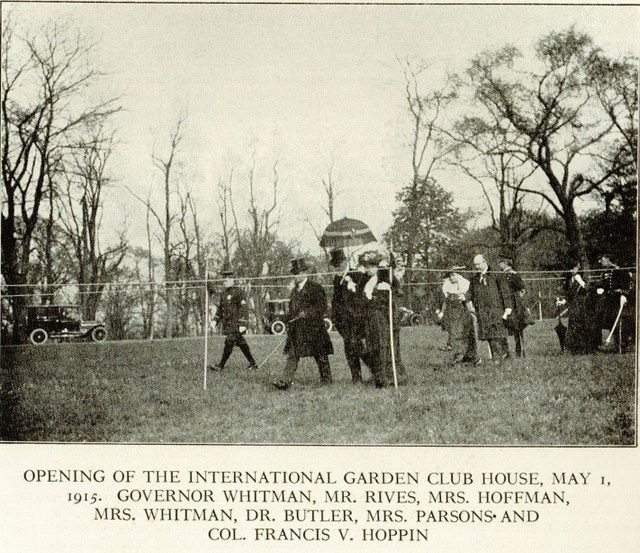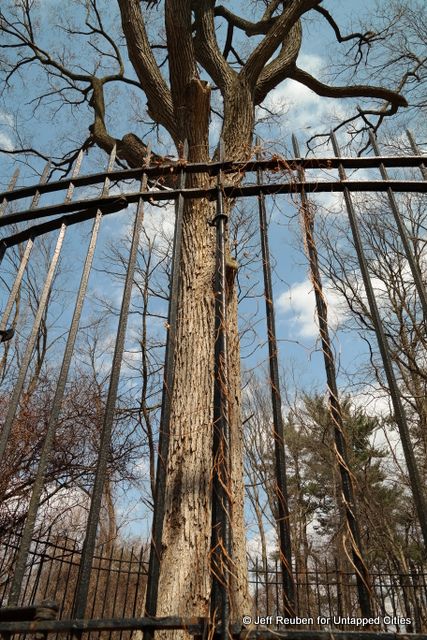Artist-Led Tour of "ENCORE" Photo Exhibit w/ Mark S. Kornbluth
Join photographer Mark S. Kornbluth for a visual exploration of NYC's Broadway theaters at Cavalier Galleries!


On May 1, 1915, the Bartow-Pell Mansion in the Bronx’s Pelham Bay Park was the site of a tree planting ceremony. That ceremony is connected to two other events, centuries apart, in which trees were at the center of deals that resolved conflicts over the land where the mansion sits.
The oak tree planted on this day 100 years ago replaced the historic Treaty Oak, which was reputed to be the location of a treaty signing in 1654 between Thomas Pell, an English settler, and Chief Wampage of the Siwanoy Indians.

Photo courtesy of the Bartow-Pell Mansion Museum
Under this agreement, Pell purchased approximately 9,000 acres, covering portions of what are now the Bronx and Westchester County. This ended years of hostilities that had resulted in deaths on both sides. One of Pell’s descendants, Robert Bartow, constructed the Bartow-Pell Mansion near the Treaty Oak in 1842.
The mansion and its grounds, including the Treaty Oak, were purchased by the City in 1888 as part of the creation of Pelham Bay Park. For the next quarter-century under City ownership, the house was vacant and fell into disrepair. The tree fared even worse; it was destroyed by fire in 1906.

Photo courtesy of the Bartow-Pell Mansion Museum
After years of neglect, in 1914 care for the house and grounds was turned over to the International Garden Club, a newly formed non-profit organization supported by many wealthy New Yorkers to promote horticulture.
The May 1st, 1915 event also formally marked the lease of the mansion and its grounds to the garden club. The New York Herald reported that “hundreds of persons prominent in society who are interested in the Garden Club attended the ceremonies.”

Image via Wikimedia Commons, Historic American Buildings Survey, 1936
The New York Times provided background on the arrangement, “the city turned over the house to the club with seventeen acres of wooded ground surrounding it, without rental. In return the club has put the house, which was sadly in need of it, in good repair, furnished it, and laid out the grounds, which are to be transformed by gardens.” The mansion served as the club’s headquarters.
However, the International Garden Club and the Parks Department soon clashed. In 1918, Joseph P. Hennessy, the newly appointed Bronx Parks Commissioner, tried to oust the club. He charged that the group was really an exclusive club and that its role as a horticultural institution was a “pretense.”
The club sued to block Hennessy’s actions, and in the case of International Garden Club Inc. v. Hennessy, the court ruled in the plaintiff’s favor, enjoining the City from evicting the Club.

The existing tree is an elm, not an oak, though nobody, even the museum, seems to know why
The matter was soon resolved, with the club agreeing to pay an annual rent of $1,000 (equivalent to about $15,500 in 2015). In his annual report for 1918, Hennessy noted that the “money was to be applied for the planting of trees within the reservation of the Garden Club.” Once again, trees figured prominently in the settlement of disputes over this land.
As for the replacement oak planted a century ago, today an elm tree stands at that location. It is unclear whether the new tree thought to be an oak was actually an elm or if the replacement oak died and an elm was later planted in its place. Regardless, it is an enduring symbol of reconciliation.
For more on the site today, see Untapped Cities’ article about the Bartow-Pell Mansion Museum.
Subscribe to our newsletter